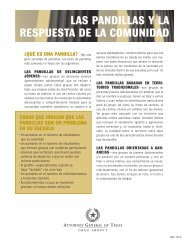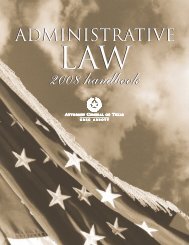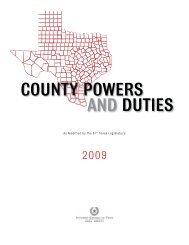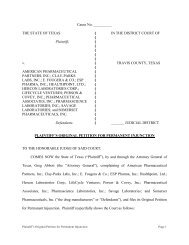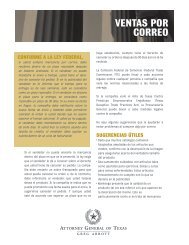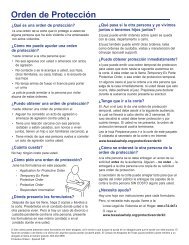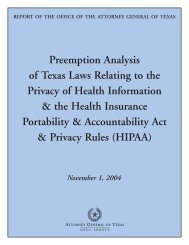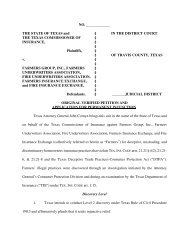Juvenile Justice Handbook - Texas Attorney General
Juvenile Justice Handbook - Texas Attorney General
Juvenile Justice Handbook - Texas Attorney General
Create successful ePaper yourself
Turn your PDF publications into a flip-book with our unique Google optimized e-Paper software.
I. Understanding the <strong>Juvenile</strong> <strong>Justice</strong> System in <strong>Texas</strong><br />
______________________________________________________________________________<br />
In 1973, the <strong>Texas</strong> Legislature enacted Title 3 of the Family Code, which formed the statutory basis<br />
for juvenile law in this state. It was enacted with the following goals:<br />
• to provide for the care and development of a child;<br />
• to remove the stigma of criminality from the unlawful acts of a child;<br />
• to separate a child from his or her parents only when necessary and to give the child needed<br />
care; and<br />
• to provide a simple judicial procedure to ensure a fair hearing and enforcement of<br />
constitutional rights.<br />
The Family Code attempted to balance the needs and rights of children against the safety needs of<br />
the community. Unfortunately, the 1973 Family Code was written for a different kind of juvenile<br />
offender from the type we presently have. The <strong>Texas</strong> juvenile justice system at the time was not fully<br />
equipped to deal with the number of juveniles committing offenses or with the extreme violence<br />
frequently perpetrated by juveniles.<br />
In 1995, the legislature revised Title 3 of the Family Code by creating the <strong>Juvenile</strong> <strong>Justice</strong> Code. This<br />
code was enacted with the following goals:<br />
• to strengthen public safety;<br />
• to promote the concept of punishment for criminal acts;<br />
• to remove, where appropriate, the taint of criminality from children committing certain<br />
unlawful acts; and<br />
• to provide treatment, training and rehabilitation that emphasizes the accountability and<br />
responsibility of both the parent and the child for the child’s conduct. (§51.01, F.C.)<br />
This <strong>Juvenile</strong> <strong>Justice</strong> <strong>Handbook</strong> provides an overview of the modern juvenile justice system in<br />
<strong>Texas</strong>. It is intended for law enforcement, parents, educators and anyone seeking information about<br />
the juvenile court process and the youth who become involved in the system. Part I introduces the<br />
juvenile system, starting with the state and local agencies and officials who implement the law. Parts<br />
II and III describe the system from the point when a child is first reported to law enforcement<br />
authorities, through intake, adjudication, disposition and imposition of the court’s order. Part IV<br />
describes a new chapter in the Family Code titled Rights and Responsibilities of Parents and Other<br />
Eligible Persons, and Part V reviews the types of cases involving children that are handled by justice<br />
and municipal courts. These step-by-step descriptions will help the reader to understand what<br />
happens to a child who becomes involved in the juvenile justice process. We hope this handbook<br />
will be useful to anyone interested in learning more about our unique and innovative juvenile justice<br />
system in <strong>Texas</strong>.<br />
State Agencies that Address <strong>Juvenile</strong> Crime<br />
In <strong>Texas</strong>, the two state agencies primarily involved in the juvenile justice system are the <strong>Texas</strong> Youth<br />
Commission (TYC) and the <strong>Texas</strong> <strong>Juvenile</strong> Probation Commission (TJPC). In addition, the<br />
Department of Family and Protective Services 1 (DFPS) and other state agencies have departments,<br />
<strong>Juvenile</strong> <strong>Justice</strong> <strong>Handbook</strong> 1<br />
Office of the <strong>Attorney</strong> <strong>General</strong>



